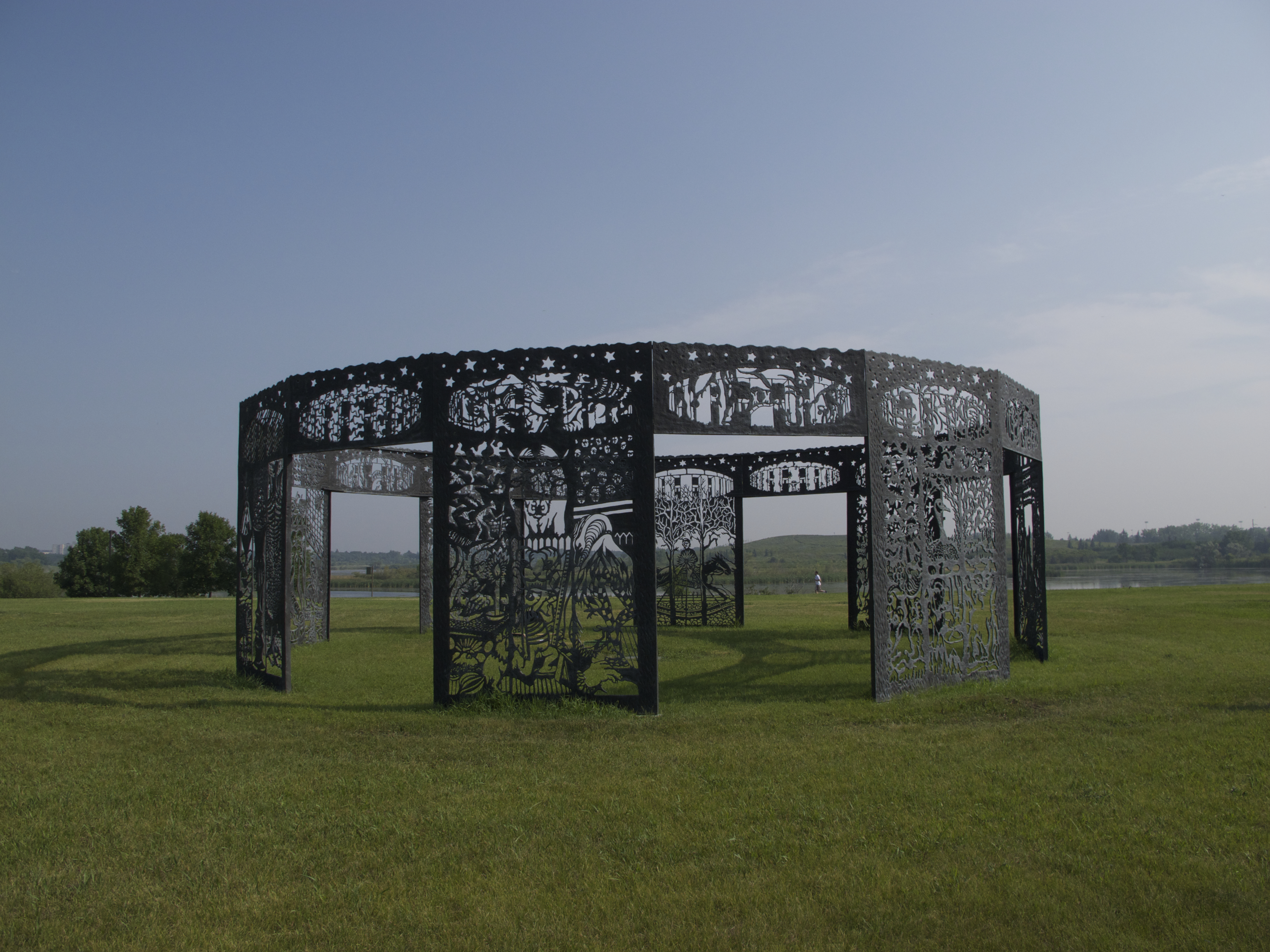(1942–2019)
North of the Dr. Archer Library and University Drive North, next to Wascana Lake

© Joseph Fafard. Reproduced with the permission of the artist. Photograph by the University of Regina.
Le jardin de l’esprit (Mind’s Garden), 1997
Bronze sandcast
University of Regina President’s Art Collection. Gift of Gordon Diamond and Joseph Fafard, 1997; pc.2005.1
For me, a clearing just north of the University of Regina, just beside Wascana Lake, has become my sacred spot, my personal Stonehenge. It contains my hopes, my disappointments, my sweat, my brain machinations, my efforts and pleasures, my tenacity, my perserverance and victory. I conceived it, carried it and brought it up. There it is – Le jardin de l’esprit.
Joe Fafard, 2006
Born in 1942 in the small French-speaking community of Ste. Marthe, Saskatchewan, Joe Fafard received his BFA at the University of Manitoba in 1966, an MFA at Pennsylvania State University in 1968. He taught as an art instructor at the University of Saskatchewan, Regina Campus from 1968-1974, and he was the recipient of an honorary doctorate from the University of Regina in 1989. His outstanding cultural contributions have significantly raised the profile of art in the province. Over an art career that spans four decades, Fafard has developed a national and international reputation for his ceramic and bronze works.
Fafard originally designed Le jardin d’esprit for a Canadian war memorial in London, England. It comprises eight panels and was constructed with the artist’s “lost Styrofoam” technique, a process in which the image is projected on Styrofoam and cut out. The Styrofoam is then shaped and rounded using a torch. The pieces are placed in sand into which molten bronze is poured, melting and replacing the Styrofoam. Each panel is then welded together. Fafard produces his bronze artworks from his foundry in Pense, Saskatchewan.
Characteristic of his œuvre, Le jardin de l’esprit features scenes depicting the province’s natural and cultural history. In it, Fafard pays tribute to the lives cut short from war, the great sacrifices made, and the loss of future experiences and accomplishments. The sculpture’s windows offer a space of reflection on these themes, whilst celebrating the survivors of war, the process of reorganization, and the effort to thrive.
Le jardin de l’esprit, 1997
Bronze coulé au sable
Collection d’objets d’art du président, Université de Regina. Don de Gordon Diamond et de Joseph Fafard à l’Université de Regina, à l’occasion de sa campagne de financement Bâtir un avenir, réaliser des rêves ; pc.2005.1
Une clairière juste au nord de l’Université de Regina, près du lac Wascana, est devenue mon recoin sacré, mon Stonehenge à moi. Elle renferme mes espoirs, mes déceptions, ma sueur, mes machinations cérébrales, mes efforts et mes plaisirs, ma ténacité, ma persévérance et ma victoire. Cette œuvre, je l’ai conçue, portée et élevée. Et la voici — Le jardin de l’esprit.
Joe Fafard, 2006
Né en 1942 dans la petite communauté francophone de Sainte-Marthe, en Saskatchewan, Joe Fafard obtient son BFA de l’Université du Manitoba en 1966, puis sa maîtrise en beaux-arts de la Pensylvania State University en 1968. Il est professeur d’art à l’Université de la Saskatchewan, campus de Regina de 1968 à 1974. L’Université de Regina lui octroie un doctorat honorifique en 1989. Ses contributions culturelles exceptionnelles ont sensiblement amélioré l’image de l’art dans la province. Au cours de sa carrière, qui couvre plus de quarante ans, Fafard a acquis une réputation nationale et internationale pour ses céramiques et ses bronzes.
Fafard conçoit initialement Le jardin de l’esprit pour un mémorial de guerre canadien, à Londres en Angleterre. Il comprend huit panneaux construits selon la technique du « polystyrène perdu » de l’artiste, procédé dans lequel l’image est projetée sur du polystyrène puis découpée. Le polystyrène est alors façonné et arrondi au chalumeau. Les panneaux sont ensuite enfouis dans du sable dans lequel on coule du bronze en fusion qui fait fondre et remplace le polystyrène. Les panneaux sont ensuite soudés ensemble. Fafard produit ses bronzes dans sa fonderie de Pense, en Saskatchewan.
Caractéristique de son œuvre, Le jardin de l’esprit dépeint l’histoire naturelle et culturelle de la province. Fafard rend ici hommage aux vies fauchées par la guerre, aux grands sacrifices consentis et aux expériences et réalisations futures avortées. Les fenêtres de la sculpture offrent des espaces de réflexion sur ces thèmes, tout en célébrant les survivants de la guerre, la réorganisation et la volonté de réussir.


